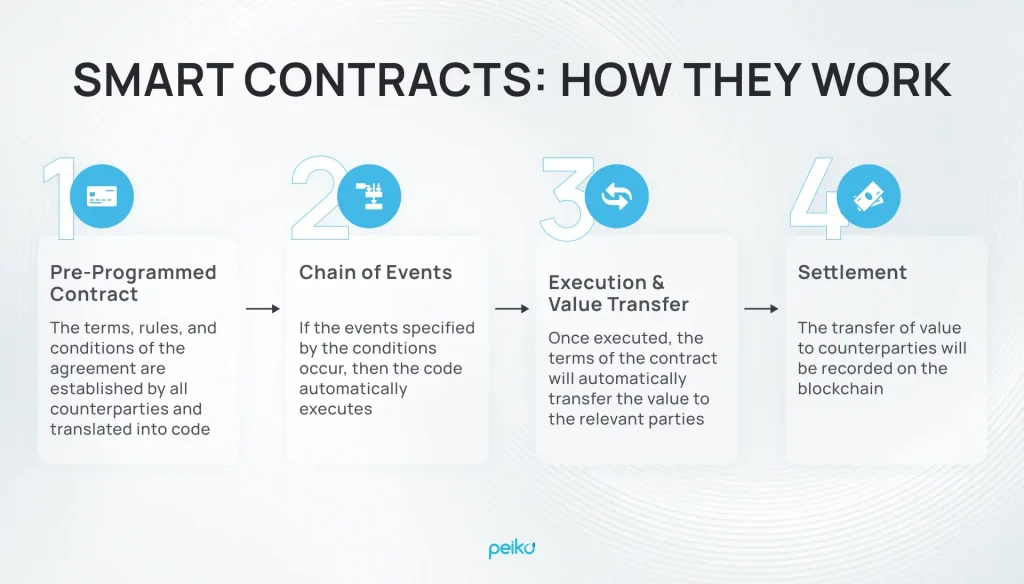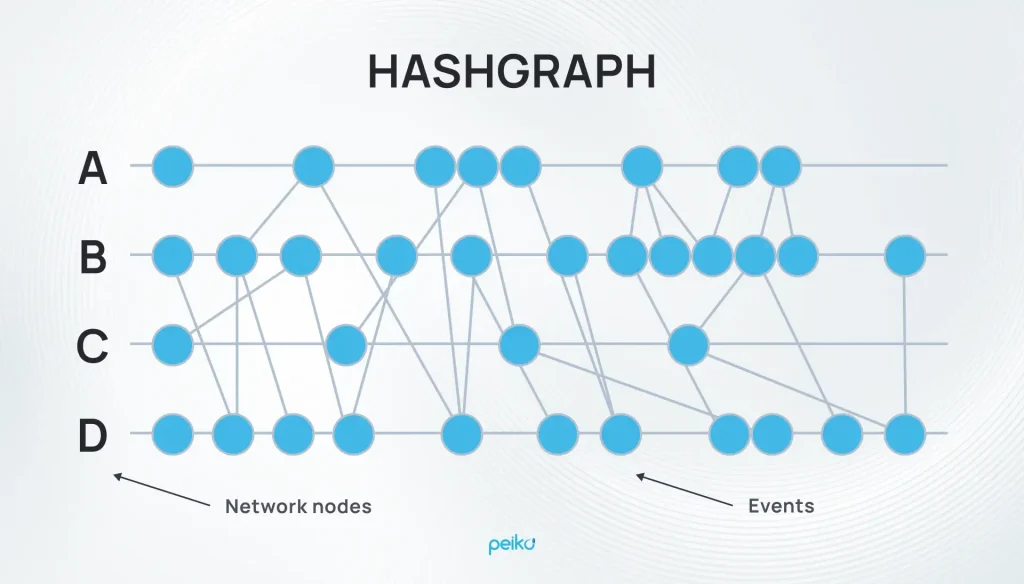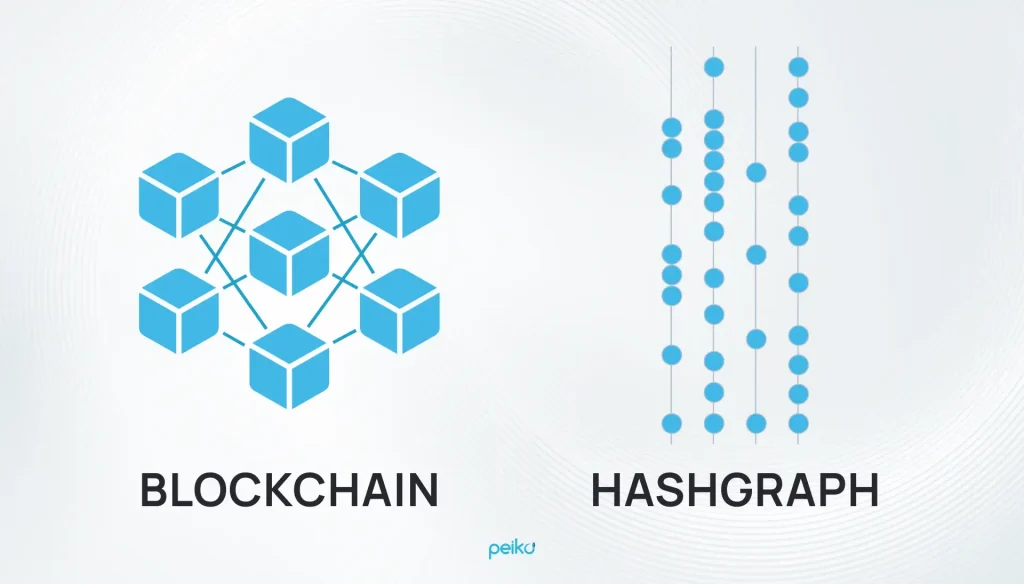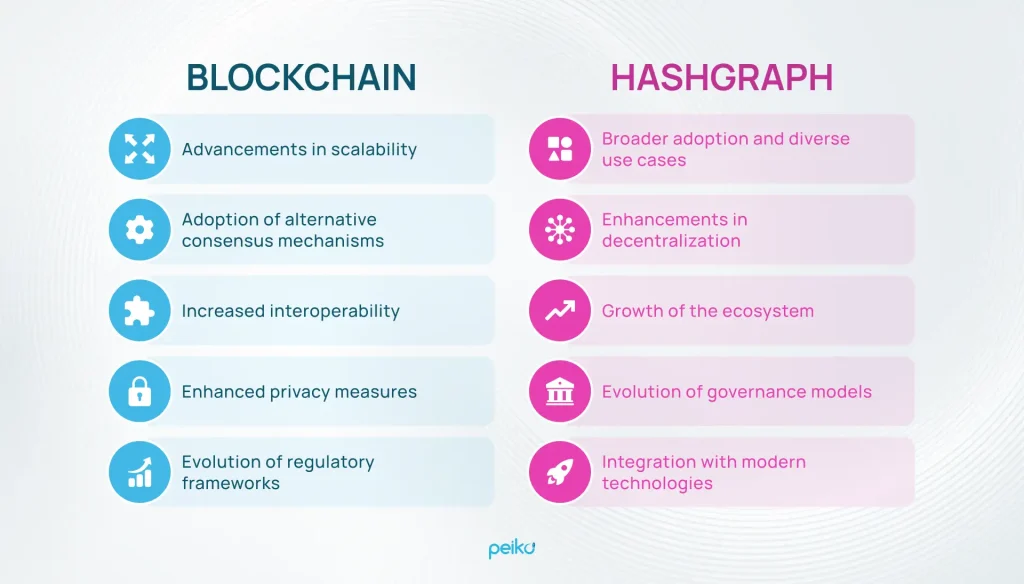In the crypto world, “distributed ledger” is often used to mean the same thing as “blockchain.” This is not a mistake, but the first term is much broader because there are different types of it.
Distributed ledger technology (DLT) is a method for managing digital databases by storing information across multiple devices. The most widespread type of DLT is blockchain, but there is also hashgraph.
Blockchain uses a chain of blocks secured by methods like proof of stake (PoS) or proof of work (PoW). Despite many advantages, blockchain has some limitations in terms of scalability and speed.
Hashgraph offers a different solution with its directed acyclic graph (DAG) structure, which can handle more transactions faster. It functions without requiring resource-intensive processes, enabling it to overcome some of the issues faced by blockchain vs DAG.
In this article, we’ll compare blockchain and hashgraph by looking at their key features, advantages, use cases, how does a hash help secure blockchain technology, and more. Let’s make blockchain and hashgraph explained and discover which one is a winner!
What is blockchain?
Let’s start with the definition. Blockchain is the most recognized form of distributed ledger technology. It gained prominence in the cryptocurrency sector following Bitcoin’s debut. Its core components include transactions recorded by validators, which create a secure, unalterable chain of blocks. The chain structure is a unique feature of the blockchain. Along with essential details, transactions also include the date of execution and the sender’s digital signature.
Blocks are supported by a hash function, which helps identify and synchronize records by differentiating and separating them from one another. The blockchain also uses cryptography and immutability for entering data, which is necessary for registry security.

Coins generally support the functioning of the entire system. They are essential for verifying transactions, rewarding validators, and other network processes.
Pros of blockchain
- Decentralization: Blockchain eliminates the need for a central authority, creating a peer-to-peer network that reduces reliance on intermediaries.
- Security: Blockchain employs cryptographic techniques, including hash blockchain functions, to secure transactions. These hashes create a unique, tamper-proof signature for every block.
- Transparency: Blockchain’s public ledger makes transactions visible to all parties, encouraging responsibility and confidence. This feature is especially useful for sectors like supply chain management.
- Immutability: Data cannot be removed or changed once it is entered into a blockchain.
- Consensus mechanisms: Several consensus techniques, such as proof of work and proof of stake, protect the integrity of the blockchain.
- Efficiency: By cutting out intermediaries, blockchain technology streamlines processes. The use of smart contracts further improves efficiency by automating and accurately executing agreements. By the way, DePIN, the new trend in blockchain technology, promises even higher efficiency capabilities.

Cons of blockchain
- Scalability issues: Compared to hash graph, the network is less scalable as it increases since it takes more time and resources to validate transactions.
- Energy consumption: Many blockchains use the proof-of-work mechanism, which demands a significant amount of processing power.
- Costly implementation: Setting up a blockchain system involves significant expenses for hardware, software, and skilled personnel. Companies ialso need to account for continuing maintenance expenses.
- Complexity: The technical concepts behind blockchain, including blockchain hash and cryptography, can be difficult for stakeholders who are not technical.
- Limited speed: Technologies like hashgraph offer faster processing capabilities, making them more suitable for applications requiring real-time data handling.

What is hashgraph?
So, what is hash graph? It is a distributed ledger built on a blockchain. A hashgraph uses a DAG, a way of structuring data, which records information non-linearly without a clear sequence of blocks. Using DAG vs blockchain is one of the core differences between a hashgraph and blockchain DLTs.

In contrast to blockchain, hashgraph documents transactions in “events” rather than blocks, and these events are stored in a parallel structure with a consistent tag. This distributed ledger also assumes data immutability. Hashgraph became publicly available for use in 2018, a technology developed by Swirlds.
The transmission of information takes place using the gossip protocol. It is called so because this protocol functions similarly to the spread of rumors. The node passes the transaction to the nodes that are nearby, and they send it on. After a few moments, the whole network knows about the new data to be added. Then, using a voting protocol, the nodes verify the transactions and write them to the registry.
But the main feature is something else. As new information is integrated into the parallel structure, earlier transactions are rolled back. Consequently, data in the hashgraph is not permanently stored. Therefore, to ensure its operation, several gigabytes of memory are needed for one node.
Pros of hashgraph
- Speed: Hashgraph uses its DAG (Directed Acyclic Graph) framework to process transactions simultaneously, resulting in exceptional throughput.
- Scalability: The ability to handle multiple transactions concurrently ensures that hashgraph can support an expanding network without slowing down.
- Fairness: The consensus mechanism in hashgraph prevents any single participant from dominating or manipulating the network.
- Security: Hashgraph’s ABFT (Asynchronous Byzantine Fault Tolerance) consensus model offers robust protection against fraud and malicious activities.
- Efficiency: Unlike energy-intensive blockchain systems, hashgraph eliminates the need for mining, reducing operational costs and energy consumption.
- Transparency: Hashgraph maintains an open ledger that provides clear visibility into all transactions and network activities.
Cons of hashgraph
- Centralization concerns: While hashgraph is theoretically decentralized, it is governed by Swirlds, the company that owns its technology.
- Limited adoption: Hashgraph is still relatively new and hasn’t been widely adopted compared to blockchain technology.
- Complexity: Understanding how hashgraph works can be challenging for non-technical stakeholders.
- Proprietary nature: Hashgraph is not fully open-source like blockchain.
- Competition with blockchain: The ongoing debate of blockchain vs hashgraph highlights that blockchain remains the dominant technology for decentralized systems.
Hashgraph vs blockchain
In this section, we will consider the key differences and similarities between blockchain and hashgraph. You will discover how each technology addresses scalability, speed, and overall efficiency.

Different features of hashgraph and blockchain
Although both blockchain and hashgraph are distributed ledger technologies, their efficiency, consensus methods, and organizational design differ. Let’s explore how hashgraph vs blockchain differ:
1. Consensus mechanisms
- Hashgraph: Utilizes asynchronous Byzantine Fault Tolerance (ABFT) and virtual voting, offering faster and more secure consensus.
- Blockchain: Employs methods like proof of work (PoW) or proof of stake (PoS), which can be slower and more resource-consuming.
2. Data structure
- Hashgraph: Uses a Directed Acyclic Graph (DAG), where transactions are linked as events, allowing parallel processing.
- Blockchain: Uses a sequential chain of blocks, requiring linear data processing and validation.
3. Speed
- Hashgraph: Boasts rapid transaction confirmation with low latency, ideal for high-frequency transactions.
- Blockchain: Has slower confirmation times due to its block-based structure and consensus processes.
4. Scalability
- Hashgraph: Highly scalable due to parallel transaction processing and efficient data sharing through the gossip protocol.
- Blockchain: Scalability depends on block size and network congestion, often limiting its throughput.
5. Governance
- Hashgraph: Managed by the Hedera Governing Council, which includes trusted organizations.
- Blockchain: Governance varies from decentralized community-driven approaches to centralized structures, depending on the implementation.
6. Energy efficiency
- Hashgraph: Highly energy-efficient as it eliminates mining activities.
- Blockchain: Energy-intensive, particularly in PoW-based systems that require significant computational power.
Similar features of hashgraph and blockchain
However, hashgraph and blockchain share several fundamental similarities, making both viable options for secure and decentralized applications.
1. Decentralization
Both systems enable decentralized networks where no single authority controls the ledger. This ensures transparency and trust among participants. The decentralized structure promotes trust and autonomy, making these technologies resilient against single points of failure.
2. Security
Hashgraph implements secure consensus with ABFT and gossip protocols, safeguarding against malicious activities. Blockchain uses cryptographic techniques and blockchain hash to secure data and maintain integrity. Both systems employ strong security measures to protect data, ensure integrity, and defend against malicious attacks, making them reliable for secure transactions.
3. Immutability
Both technologies ensure that a transaction cannot be changed once it has been recorded, promoting data integrity and reliability. The guarantee the integrity of records, making them reliable for auditing, compliance, and legal purposes.
4. Transparency
Both provide open access to transaction history for network participants, enhancing accountability. Being transparent encourages accountability since each transaction can be traced back to its origin without compromising security. It’s a crucial feature for applications requiring public trust, such as supply chain tracking and financial services.
5. Versatility
Hashgraph and blockchain can both be applied across industries like finance, healthcare, and supply chain management, showcasing their adaptability to diverse use cases. For instance, they can streamline operations in finance, healthcare, logistics, real estate, and more, thanks to their ability to facilitate secure and efficient transactions.
6. Distributed ledger
Both operate as distributed ledgers, ensuring that each node in the network holds a copy of the transaction history. This redundancy prevents data loss and allows the network to remain operational even if some nodes fail or are compromised.
Use cases of hashgraph vs blockchain
Both blockchain and hashgraph present unique benefits and are tailored for different applications. Let’s consider their use cases.
Hashgraph use cases
- Rapid Hedera transactions: Hashgraph is perfect for environments demanding swift transaction speeds, such as financial payment networks and real-time analytics.
- High-throughput dApps (decentralized applications): Well-suited for decentralized applications needing efficient processing and minimal delays, like interactive gaming platforms and supply chain solutions.
- Digital voting: Ideal for creating secure and transparent voting systems, benefiting from Hashgraph’s quick consensus and resistance to tampering.
Blockchain use cases
- Digital currencies: Blockchain is the foundation for cryptocurrencies such as Bitcoin and Ethereum, offering a secure and transparent approach to digital financial transactions.
- Automated contracts: Facilitates the creation of smart contracts on platforms such as Ethereum, which are used for automating and managing agreements in sectors like trade finance and legal services.
- Supply chain transparency: Enhances visibility and traceability in supply chains, allowing for the verification of product origins and movement throughout the distribution process.
Challenges and limitations of blockchain and hashgraph
Both Hedera blockchain face distinct challenges and limitations. Let’s consider them in more detail.
Blockchain challenges and limitations
Blockchain has many benefits, but it also has some problems that could slow it down or stop many people from using it.
Scalability constraints
A primary challenge with blockchain technology is its scalability. Many traditional blockchains, such as Bitcoin and Ethereum, struggle to process transactions efficiently as their networks grow. This is largely due to the reliance on consensus mechanisms like PoW, which require extensive computational effort and time. As transaction volumes rise, these networks may face delays and elevated transaction fees.
Excessive energy consumption
Unlike DAG blockchain is more energy-consumptive. The PoW consensus algorithm, used by Bitcoin and similar blockchains, demands significant computational power, leading to substantial energy use. This has raised concerns about the harmful environmental impact, with energy consumption levels comparable to those of small nations.
Throughput limitations
Blockchain networks often have a limited transaction processing capacity. For instance, Bitcoin processes approximately 7 transactions per second (TPS), whereas Ethereum handles around 119 TPS. Conventional financial systems like Visa can manage thousands of transactions per second. This limited throughput can restrict blockchain’s scalability and suitability for large-scale applications.
Security risks
Although blockchain is recognized for its security capabilities, it is not free from risks. One notable threat is the attack, where an individual or group gains control of more than half of the network’s mining power, which can pose serious risks. Additionally, vulnerabilities in smart contracts, which execute agreements through code, can lead to exploitation and financial losses.
Regulatory issues
The regulatory landscape for blockchain technology is still evolving. The uncertainty in regulations can hinder innovation and adoption, as different areas impose diverse rules.
Hashgraph challenges and limitations
Hashgraph adopts a new method, but it also faces some problems that could stop it from being widely used and slow it down.
Potential centralization
Although hashgraph aims to address some of blockchain’s issues, it has faced scrutiny regarding centralization. Unlike blockchain’s typically decentralized networks, hashgraph’s governance can lead to more centralized control. The initial setup and management of the network might influence its overall decentralization and trustworthiness.
Adoption and maturity issues
Hashgraph is relatively new compared to blockchain technology. It has not yet achieved the same level of adoption or demonstrated the same robustness in practical applications. The development ecosystem around hashgraph—including developer resources, community engagement, and use cases—is still evolving.
Licensing and intellectual property concerns
Hashgraph operates under different licensing terms and intellectual property constraints than open-source blockchain platforms. For instance, Hedera hashgraph is a permissioned network with proprietary aspects, which can limit public access to its source code and hinder transparency and innovation.
Developing ecosystem
The hashgraph ecosystem is still in its formative stages compared to the more mature blockchain landscape. The availability of tools, platforms, and services for hashgraph is limited, which can restrict its use cases and overall adoption.
Complexity of implementation
Hashgraph introduces a distinct consensus mechanism and data structure, making it more complex to understand and deploy compared to traditional blockchain systems. This complexity may slow down adoption and integration into existing practices and technologies.
In general, blockchain technology excels in decentralization and security but struggles with scalability and energy consumption. Hashgraph presents solutions to some of these issues but faces its own set of challenges related to centralization, adoption, and ecosystem development.

Hashgraph vs blockchain comparison: How to choose?
Distributed ledger technology has the potential to revolutionize industries worldwide. Two of the most prominent DLT platforms, blockchain and hashgraph, have captured the imagination of technologists, entrepreneurs, and investors alike.
Let’s find out what prospects and transformations await these technologies.
Potential developments in blockchain technology
1. Advancements in scalability: Future improvements in blockchain technology are expected to tackle current scalability issues. Innovations such as Layer 2 solutions—including Bitcoin’s Lightning Network and Ethereum’s rollups—are set to boost transaction capacity by processing transactions off the main blockchain. Additionally, sharding, which divides the blockchain into smaller, more manageable segments, could further enhance scalability.
2. Adoption of alternative consensus mechanisms: The transition to more efficient consensus algorithms like PoS is becoming increasingly prevalent. Ethereum’s upgrade to Ethereum 2.0, which incorporates PoS, highlights this shift. Other consensus methods, such as delegated proof of stake (DPoS) and various Byzantine fault tolerance models, are also being explored to improve speed and reduce energy consumption.
3. Increased interoperability: Future blockchain developments are likely to emphasize better interoperability among different networks. Innovations such as cross-chain bridges and decentralized exchanges are expected to enable seamless communication and data transfer across various blockchains. This will lead to a more integrated blockchain environment.
4. Enhanced privacy measures: Privacy is a key focus for future blockchain enhancements. Technologies like zero-knowledge proofs (e.g., zk-SNARKs) and secure multi-party computation are being refined to ensure transactions and user information remain confidential while maintaining blockchain integrity.
5. Evolution of regulatory frameworks: As blockchain technology matures, clearer regulations and standards are anticipated to emerge. They will provide a structured framework that balances innovation with security and supports blockchain technologies’ broader adoption.
By the way, we invite you to head over to our blog to discover more about blockchain, including groundbreaking topics like What is DeSci? Dive into how the latest blockchain innovations are transforming industries.

Potential developments in hashgraph technology
1. Broader adoption and diverse use cases: Hashgraph is poised for wider adoption as its benefits become more recognized. Its capabilities, such as high transaction speeds and low costs, could drive its use in various industries, including finance, supply chain management, and decentralized applications.
2. Enhancements in decentralization: Future efforts in this technology may focus on reducing centralization concerns. By fostering a more distributed network and involving a broader range of participants, hashgraph could improve its overall trustworthiness and security.
3. Growth of the ecosystem: The hashgraph ecosystem is expected to expand with the development of more tools, platforms, and services. Increased support for developers, a stronger infrastructure, and more Hedera hashgraph careers will be essential for spurring innovation and encouraging the widespread use of this technology.
4. Evolution of governance models: Future hashgraph implementations may explore advanced governance models to balance efficiency and decentralization. Innovations in governance could involve more flexible decision-making processes and enhanced stakeholder participation, contributing to a more resilient and adaptable network.
5. Integration with modern technologies: Hashgraph could see greater integration with emerging technologies such as artificial intelligence (AI). These integrations may enhance Hashgraph’s functionality and open new avenues for its application across various sectors.
Which technology might dominate in the future?
The question of whether blockchain vs hashgraph will dominate the future depends on several critical factors, including their ability to address scalability, decentralization, efficiency, and adoption challenges.
Blockchain currently has a strong foothold due to its established presence and extensive ecosystem. Its continuous evolution, with improvements in scalability and privacy, suggests it will maintain a significant role. The broad adoption and active developer community further solidify blockchain’s position.
Hashgraph, however, offers distinct advantages, such as faster transaction speeds and reduced operational costs. If it can effectively address its centralization issues and expand its ecosystem, Hashgraph could become a major player, particularly in environments that demand high performance and efficiency.
The future landscape may see both technologies coexisting and complementing each other, leading to a diverse and dynamic tech environment.
Peiko as your reliable blockchain development partner
Our team has gained trust as one of the best blockchain development firms. Positive reviews of our clients on platforms like GoodFirms, Clutch, TopDevelopers, and others speak for themselves.
Fintopio is one of the successful blockchain projects we worked on. The client turned to us with the request to create a sophisticated platform integrating both decentralized and centralized finance functionalities. The project aimed to streamline cryptocurrency transactions by enabling easy conversion between crypto and fiat currencies and incorporating tools for swaps and bridges.
A top feature was the Fintopio Telegram Mini App, designed to simplify asset transfers by allowing users to send assets using usernames instead of complex wallet addresses.

Our professional blockchain developers delivered a comprehensive solution by creating a cross-platform application accessible via web, iOS, Android, and Telegram. We integrated DeFi (decentralized finance) and CeFi (centralized finance) wallets and ensured robust encryption and user-friendly interfaces.
Our design focused on seamless navigation and visual appeal, enhancing user experience. We also incorporated major blockchain support and integrated third-party services for instant swaps and real-time data.

The successful launch of Fintopio, now a leading Mini App in the crypto sector, on the top 14 Telegram Mini Apps, shows our ability to deliver secure, innovative, and user-centric blockchain solutions.
Turn to us for quality Telegram Mini App creation, crypto wallet development services, and crypto exchange development like Swych. If you have any other requests, we will help you.
Conclusion
So, which technology is better – hashgraph vs blockchain? There is no clear answer. Blockchain is renowned for its decentralization and immutability, making it ideal for secure and transparent applications such as cryptocurrencies, smart contracts, and supply chain management.
Hashgraph offers high-speed transactions, lower costs, and scalability through its innovative consensus mechanism and data structure. This makes it suitable for applications needing rapid processing and efficiency, such as high-frequency trading and real-time data systems. Despite its advantages, of course, the hashgraph will not kill the blockchain.
New cryptocurrencies don’t kill Bitcoin—why should another distributed ledger kill the blockchain? After all, the project’s history, popularity, community, and infrastructure play a vital role. In any case, the potential pros of the hashgraph make it a very interesting project worth following closely.
If you have an idea for the next revolutionary blockchain project, turn to Peiko. We will help you implement your idea according to your requirements. So, you will get a successful blockchain project like Swych, Fintopio, or Orion Protocol.







![How to Create a DAO in 8 Steps: a Detailed Guide [2025]](https://peiko.space/app/uploads/2025/06/UvAP8IGJGx56F2VR.webp)


